Top 12 Botpress Alternatives for 2026

Preetam Das
August 26, 2024
14 min
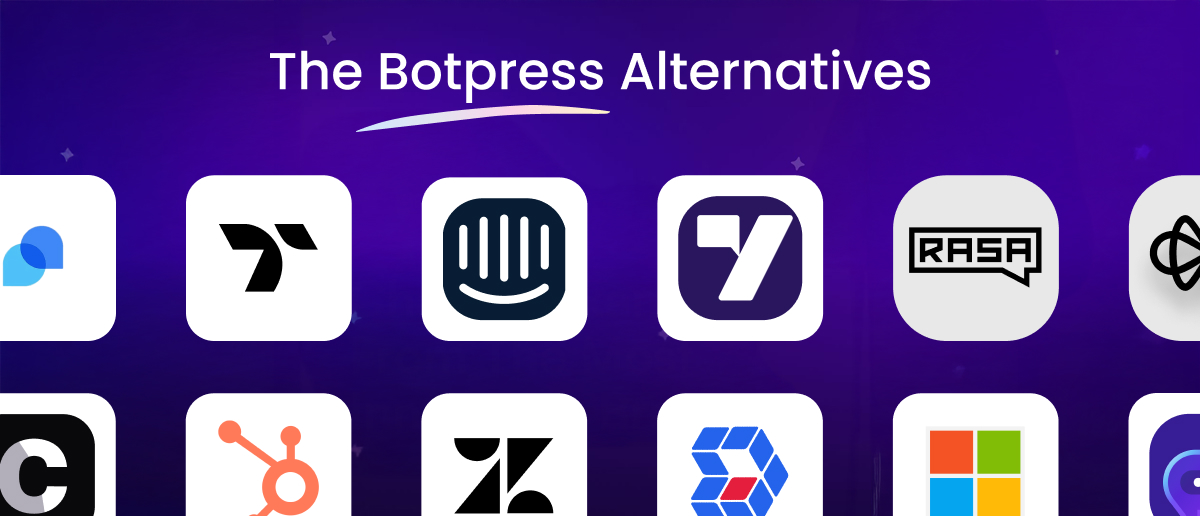
Table of Contents
The core strength of any AI chatbot builder driven by advanced Large Language Models (LLMs) is delivering automation efficiency without losing the personal touch. Botpress has positioned itself as one of the leading open-source platforms in the conversational AI space, allowing users to build and deploy AI chatbots and agents using GPT and other advanced lae language models.
Why Businesses are Exploring Botpress Alternatives
Although Botpress is a popular platform with a strong focus on flexibility and AI automation, it’s not the right fit for every business. It has its limitations, and users have also pointed out a few pain points. Here are some of the most common reasons why businesses start looking for Botpress alternatives:
- Steep learning curve
While building a basic bot is easy, working with advanced features like variables, flow logic, or API calls can get technical. Non-developers often find it hard to keep up without coding experience. - Requires coding for custom integrations
If you want to connect Botpress to other tools or platforms using APIs, you’ll likely need to know how to code. This makes it more developer-focused and less accessible for no-code teams. - Knowledge base struggles with complex data
The Knowledge Agent doesn’t work well with complex or detailed CSV files. There are also limits on data rows and vectors, which can affect accuracy and response quality. - Channel integration can be complicated
Connecting to platforms like Facebook or Instagram means working with Meta’s developer tools and approval process, which can slow down deployment. - Flow-based architecture can feel rigid
Botpress relies heavily on flow-based designs, which may not handle unexpected inputs or dynamic conversations as smoothly as newer AI agent platforms.
Choosing the right AI chatbot platform for your business can be difficult, especially with so many options and technologies available in the market.
In this article, we have researched and put together a list of 12 best Botpress alternatives in 2026. Whether you’re just starting out or already scaling, the players mentioned here will help you find the platform that fits your business best.
12. HubSpot Service Hub (with Chatbot Builder)
1. Thinkstack.ai
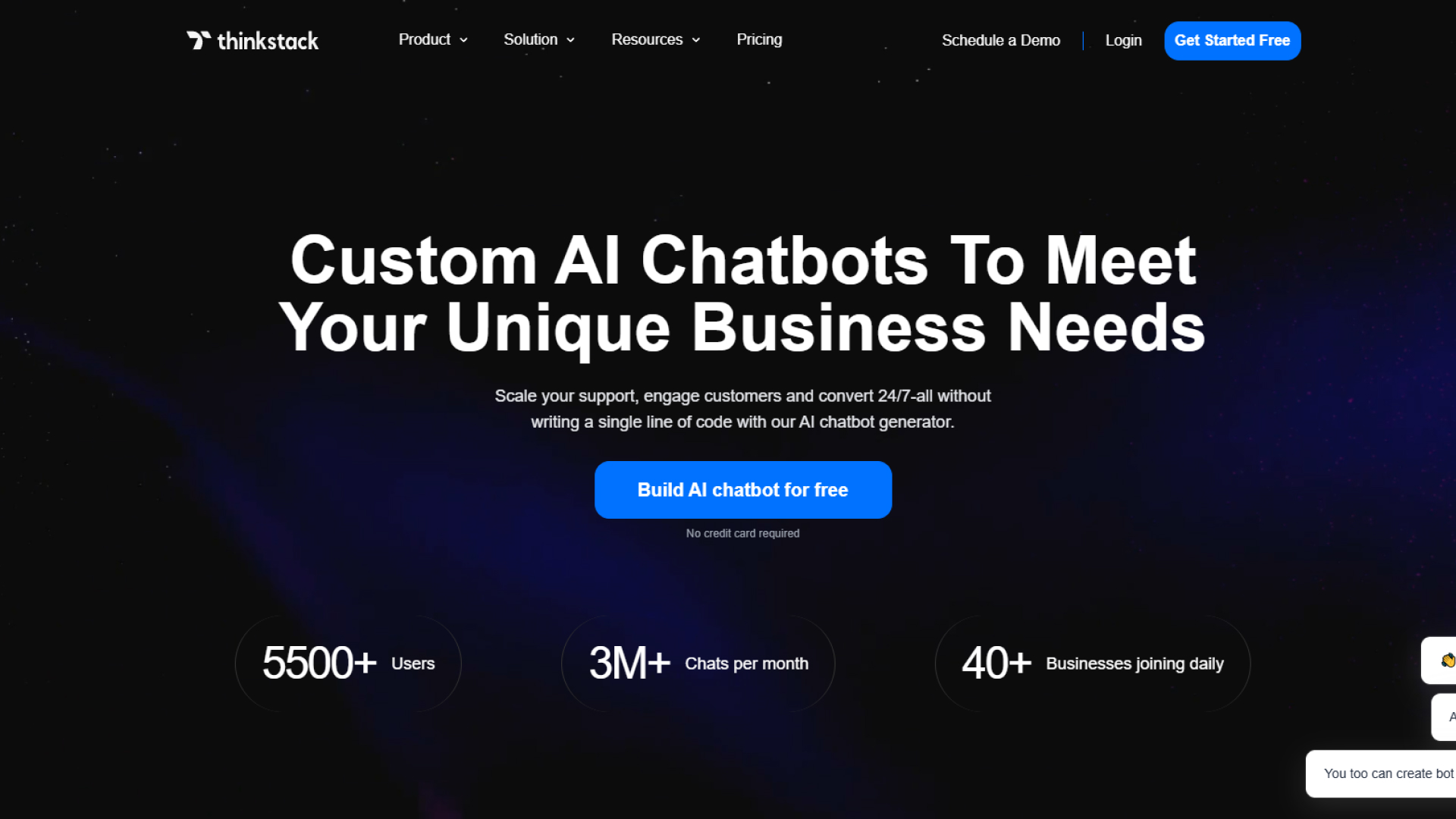
Thinkstack is a no-code AI chatbot generator that lets you create smart, personalized chatbots without writing any code. You can train your chatbot using your own content, like website pages, PDFs, or Q&A documents, so it gives answers that match your business.
It works on advanced GPT models to deliver human-like conversations. You can use it for customer support, lead capture, or automating tasks, and easily deploy it on your website, app, or social media. It’s simple to use and built for businesses that want to connect with customers quickly and effectively. It is used by over 5,500 users, manages more than 3 million conversations each month, and adds over 40 new users daily.
Key Features
- Quickly build and launch your AI chatbot without writing any code.
- Train your chatbot on your knowledge base, be it internal docs, FAQs, or CSVs, for accurate responses.
- Deploy your chatbot on websites, mobile apps, and platforms like Slack, WhatsApp, Messenger, and Instagram, with support for builders like Wix, WordPress, Webflow, Squarespace, and Weebly, all from a single dashboard.
- Automate repetitive workflows, follow-ups, and data collection using built-in intent detection and customizable actions.
- Collect leads or user details through conversational forms that feel natural and engaging.
- Get insights, spot trends, and understand patterns with built-in sales analytics by simply uploading reports, logs, or CSV files and chatting with your data.
- Handle complex queries smoothly by passing them to human agents with full context and no repetition.
- It supports 90+ languages with automatic language detection and fully supports RTL (right-to-left) languages, ensuring messages always appear as they should.
- Customize logos, colors, headers, and more to ensure visual consistency across all touchpoints.
- Set your chatbot’s tone, behavior, and fallback responses using custom instructions and model settings.
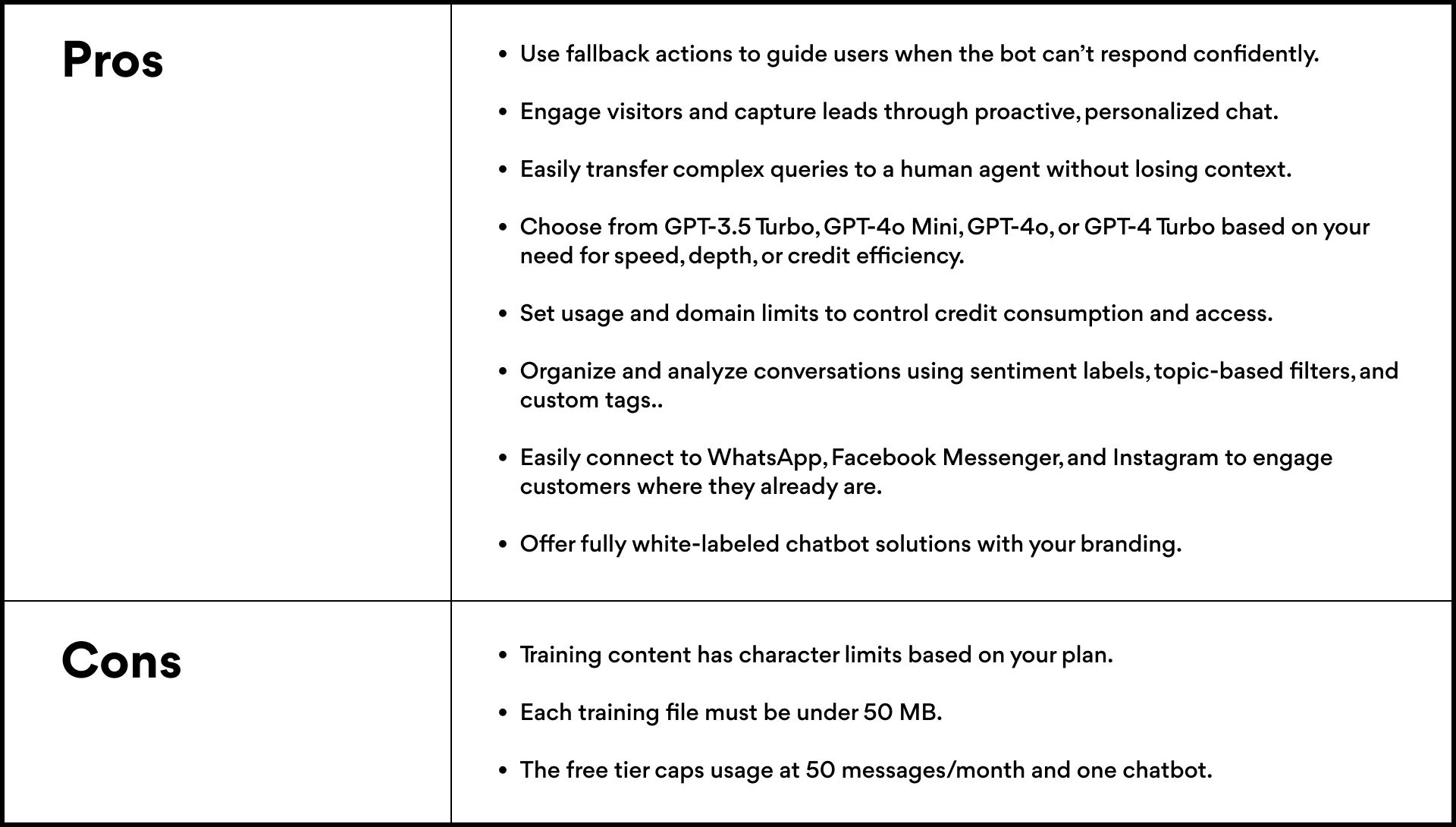
2. Tidio
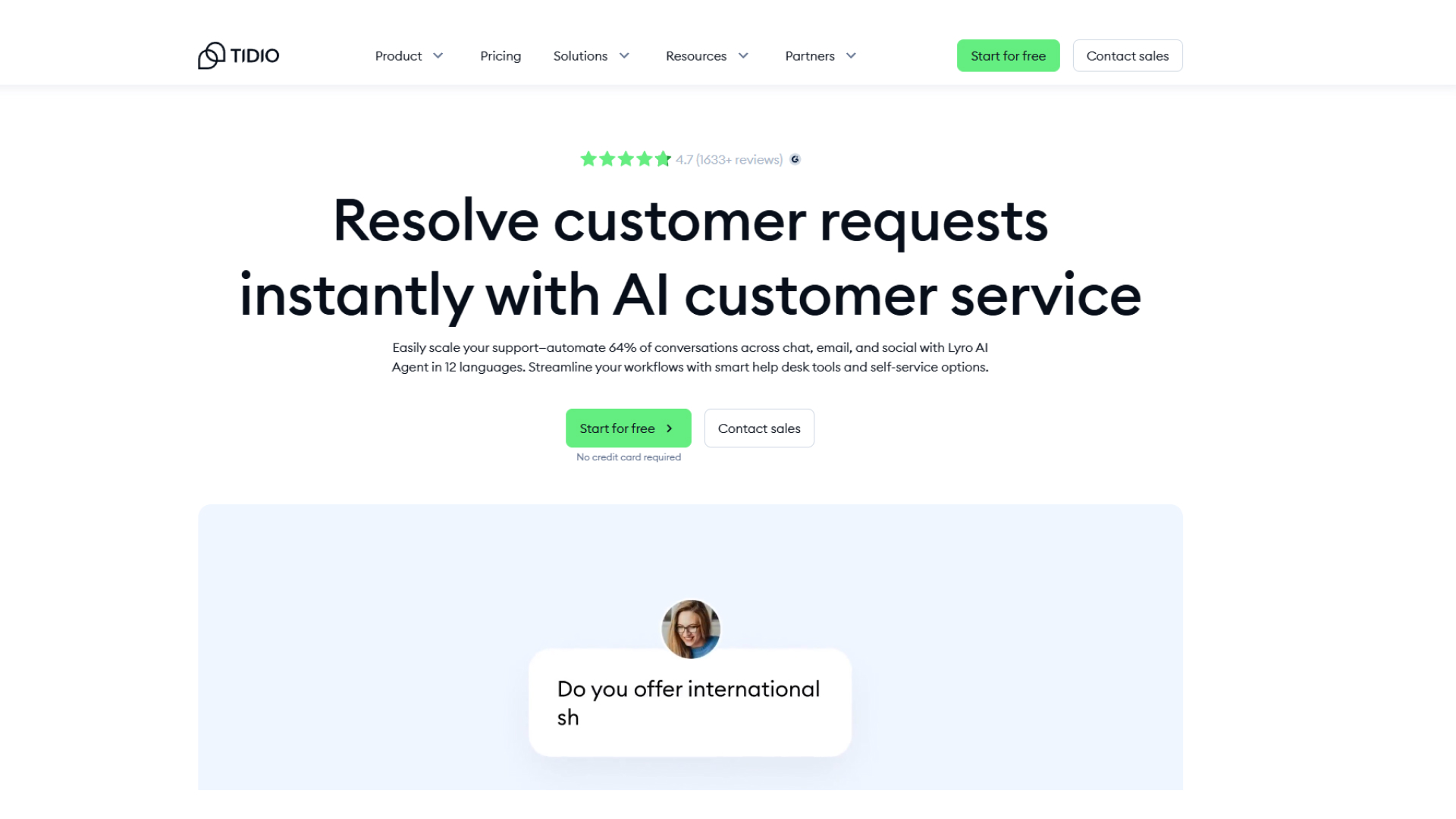
Tidio is an all-in-one customer service platform. It combines live chat, chatbot automation, and helpdesk tools into a single solution. With Tidio, businesses can offer real-time support, automate routine questions, and streamline communications, all without multiple platforms.
Key features
- Automate up to 64% of routine chats with Lyro AI, trained on your website and FAQ content for instant, human-like replies.
- Chat with visitors in real time through a customizable widget with mobile app access for on-the-go support.
- Build chatbots fast using a visual drag-and-drop builder with 16 free templates for lead capture, cart recovery, and more.
- Manage messages from Messenger, Instagram, email, and more in one inbox without switching tabs.
- Connect with platforms like Shopify and WordPress to pull in order, product, and customer data for smarter, real-time conversations.
- See who’s on your site, what pages they’re browsing, and what they’re typing, making it effortless to engage at the right time.
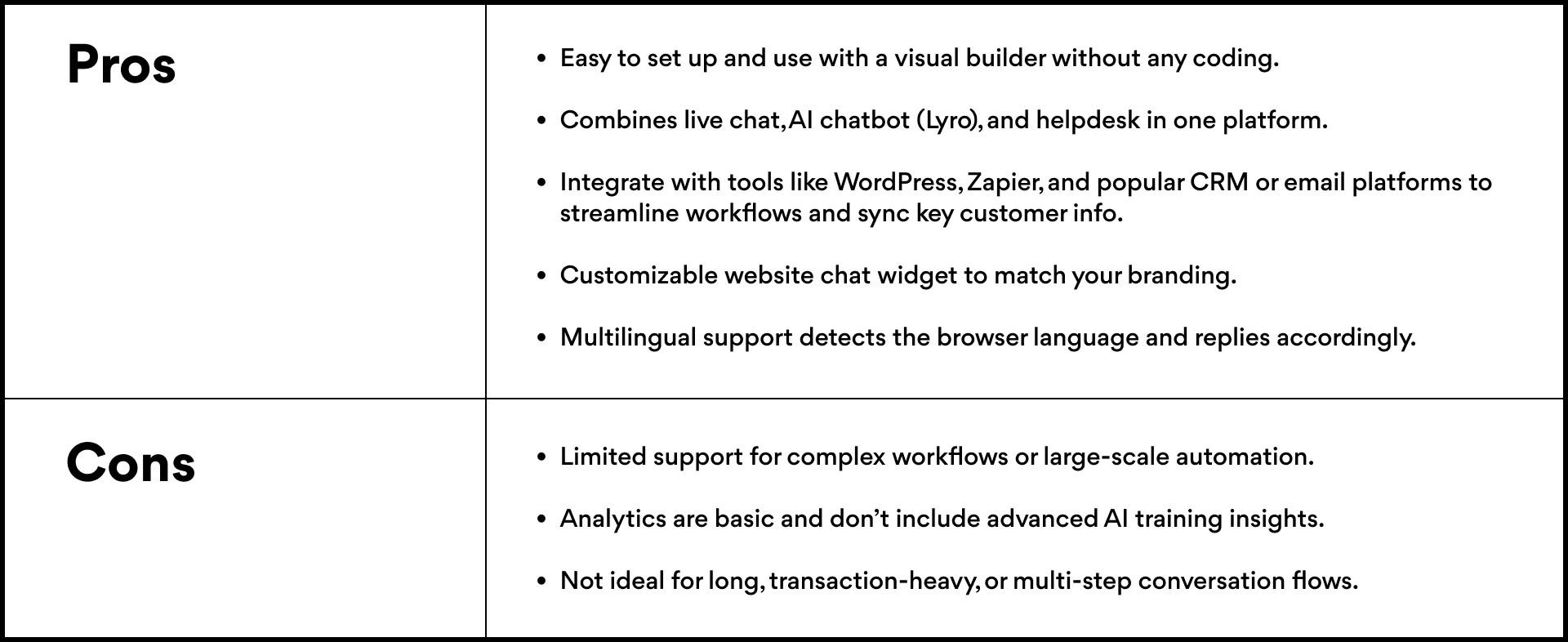
Also read: Best Tidio alternatives in 2026
3. Yellow.ai
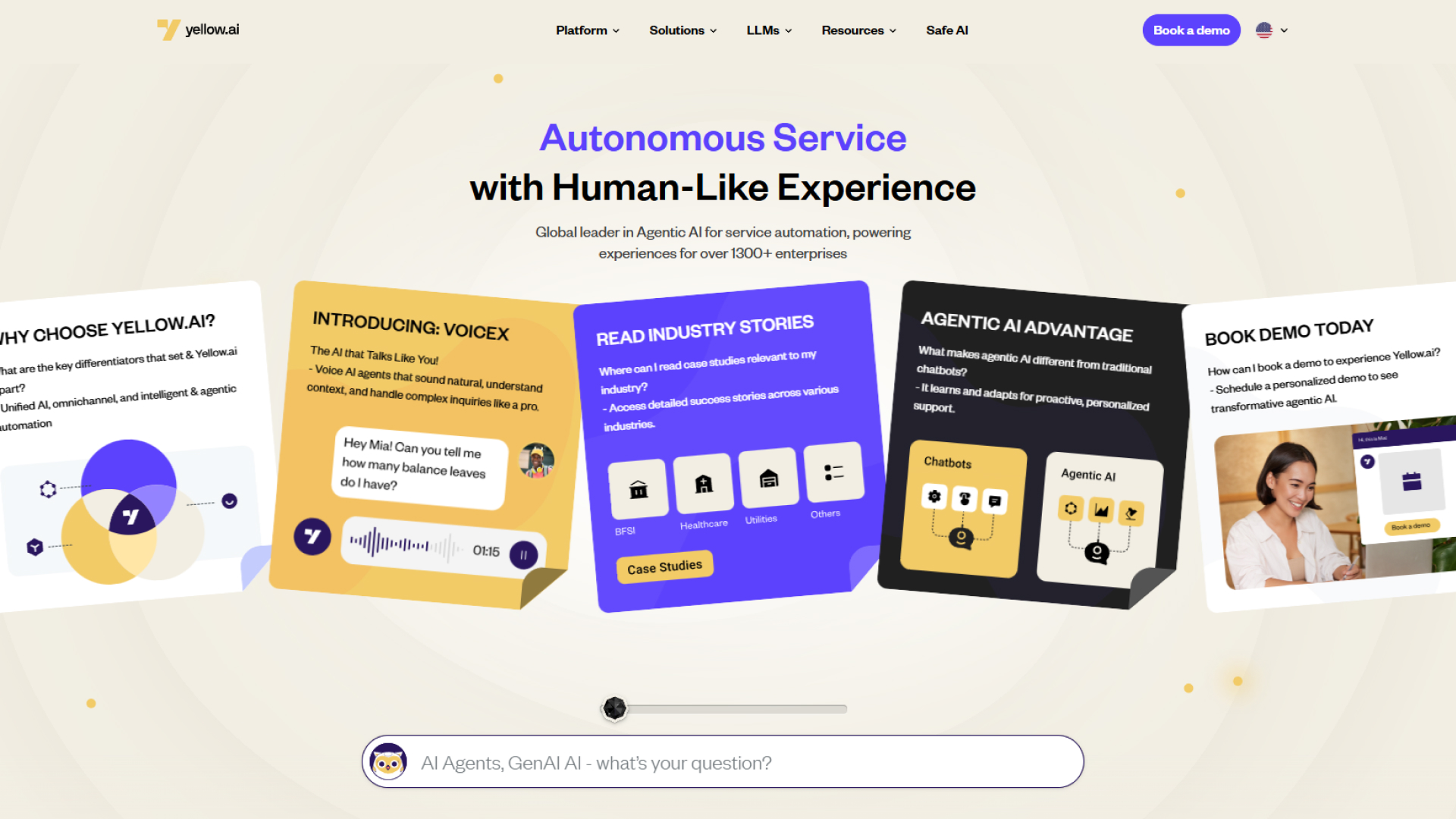
Yellow.ai is a powerful no-code AI platform designed to automate customer support, sales, and engagement across voice, chat, and email. By utilizing generative AI and enterprise-grade language models, Yellow.ai can provide seamless, human-like conversations in real time across 35+ channels, from websites to mobile apps, WhatsApp, and social media.
Key features
- Deliver real-time, human-like voice responses with emotion detection for natural, engaging conversations across multiple languages.
- Support over 135 languages, including regional dialects like Spanglish and Hinglish, to connect with global customers in their preferred language.
- Provide instant, accurate answers by connecting data from CRMs, ERPs, and internal docs into one unified knowledge base.
- Track real-time metrics through intuitive dashboards to improve support, optimize engagement, and drive better decisions.
- Stay compliant with HIPAA, GDPR, SOC 2, and ISO standards—ideal for industries with strict security and privacy needs.
- Deploy AI agents across 35+ channels, including web, mobile apps, WhatsApp, and voice IVR, for consistent customer engagement everywhere.
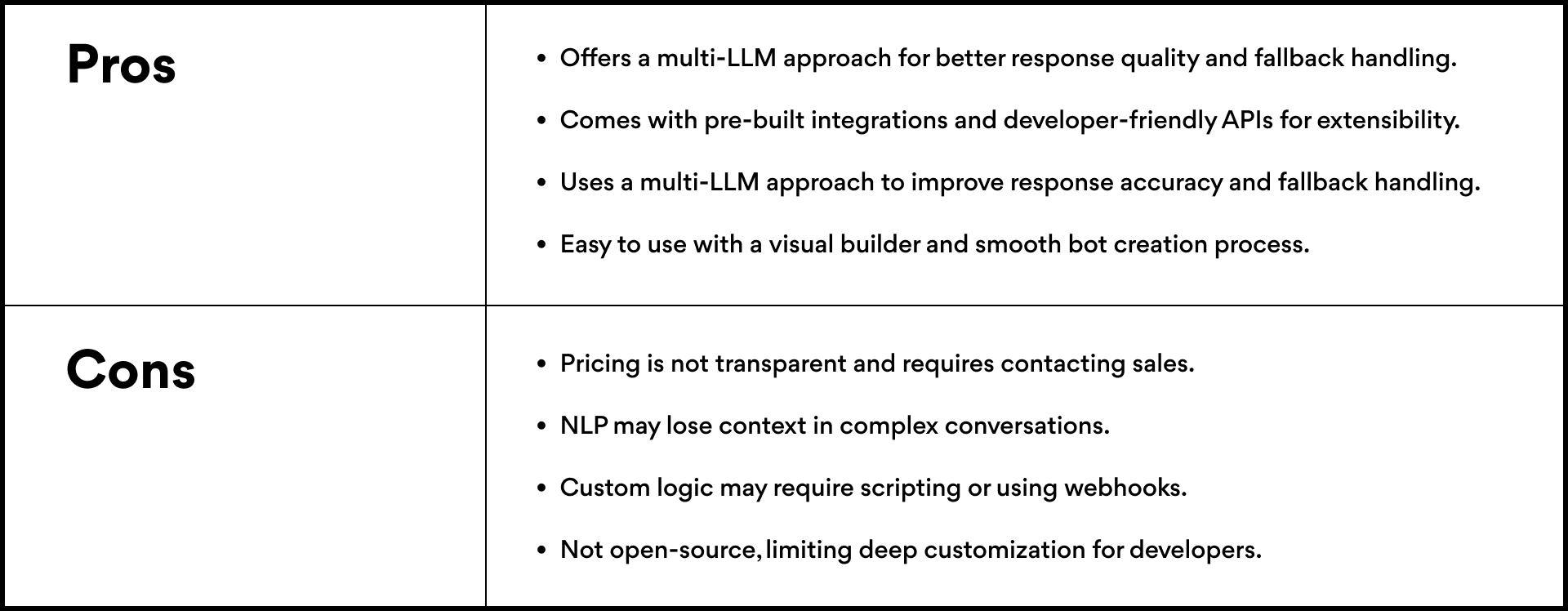
4. Intercom
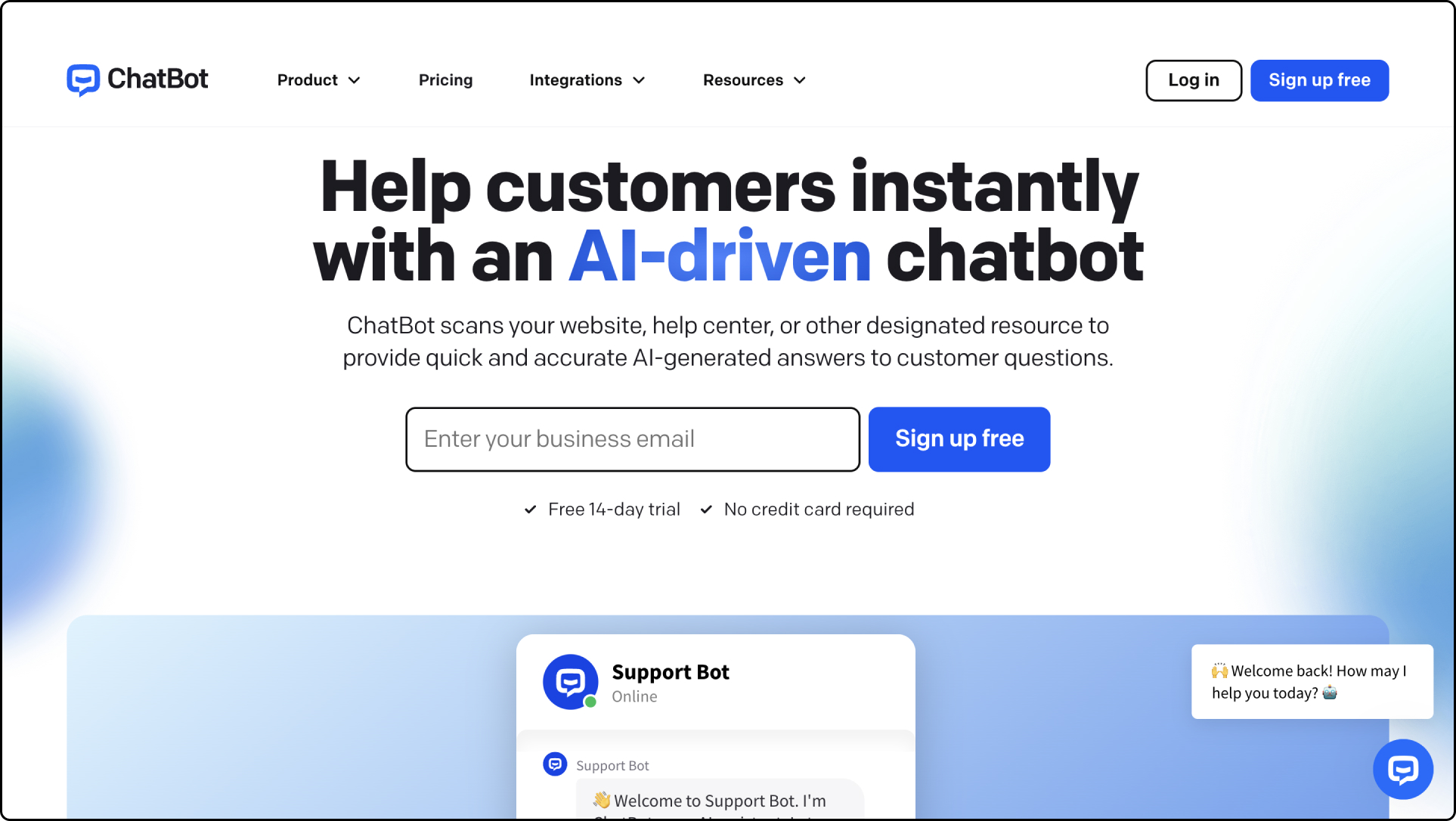
Intercom is an AI-first customer service platform designed to enhance support, engagement, and sales through a mix of AI-driven chatbots, automation, and live chat features. Its centralized system allows businesses to manage customer conversations across email, chat, social media, and in-app messaging all within a single interface. Intercom is widely used by SaaS companies, B2B teams, and medium to large enterprises seeking to streamline their customer service processes.
Key features
- Automate repetitive tasks like order tracking and lead qualification with AI chatbots tailored to your workflows.
- Set up behavior-based automations to follow up on carts, onboard users, and escalate complex issues when needed.
- Offer real-time support through chat widgets with built-in ticketing to manage and track complex issues.
- Track customer satisfaction, agent performance, and chat data with detailed analytics to improve support.
- Capture and manage qualified leads using proactive chat campaigns that sync directly with your CRM.
- Respond faster with a shared inbox that brings together chat, email, social, and in-app messages in one place.
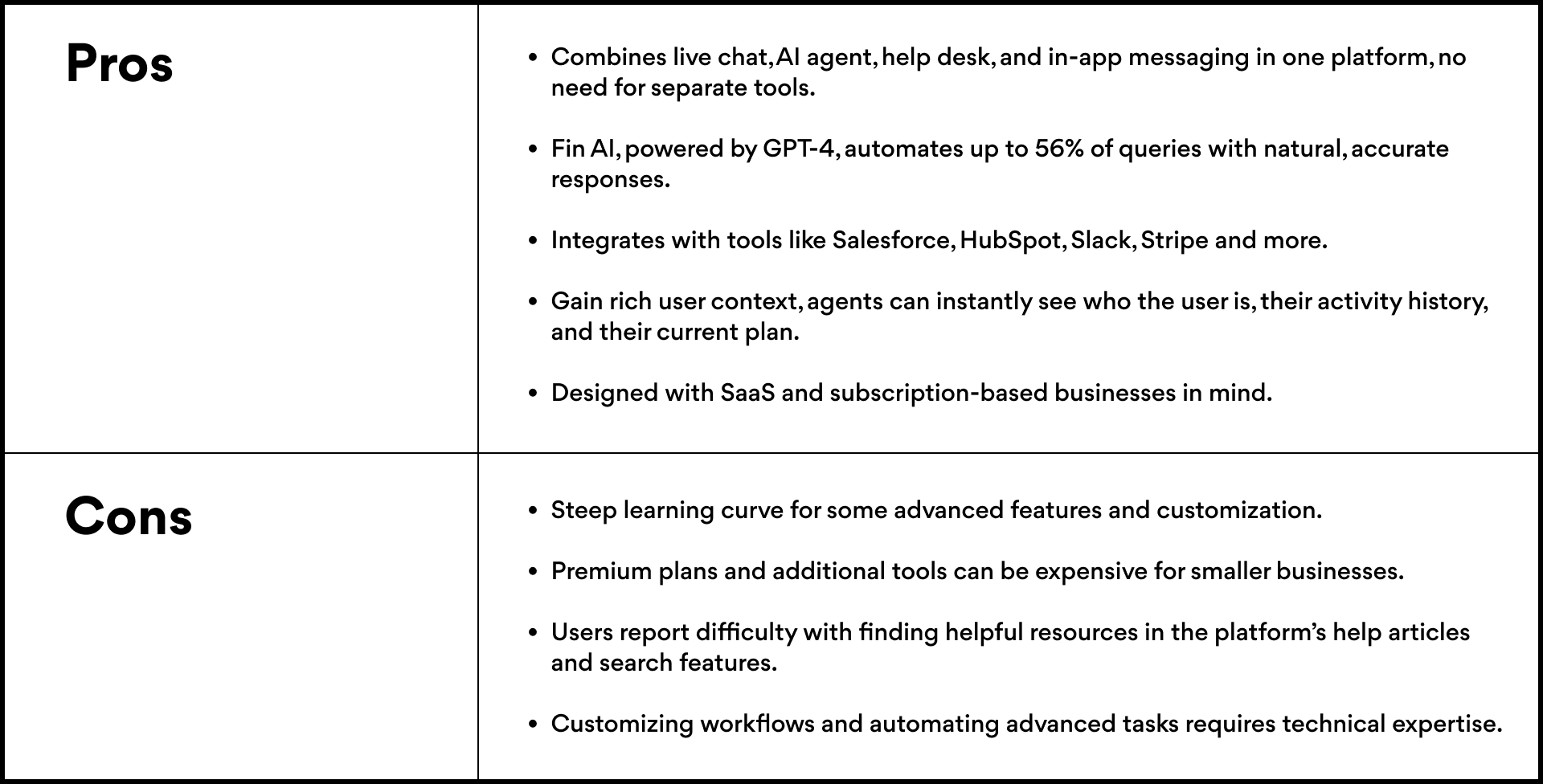
- Other interesting reads:
5. Chatbase
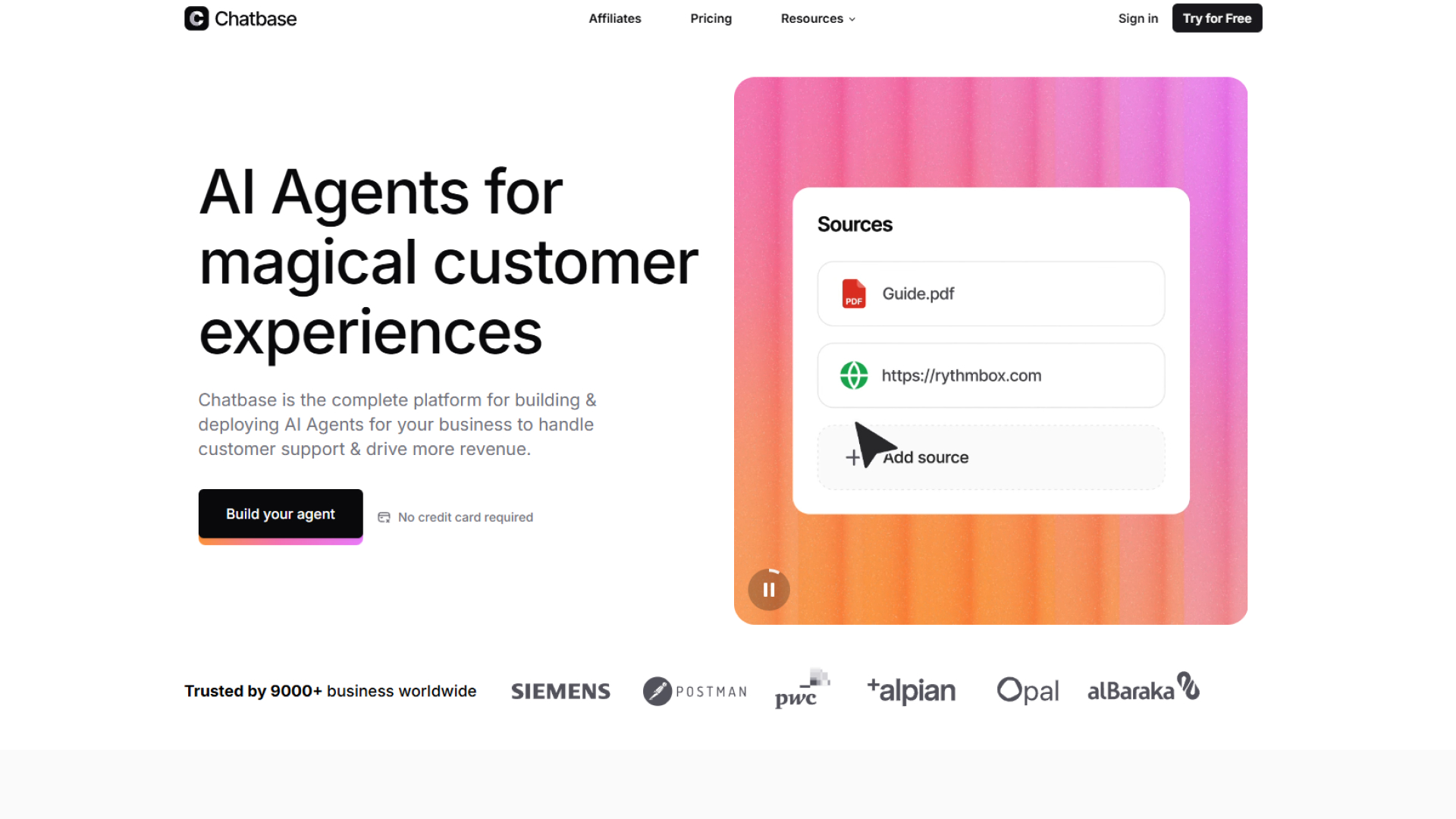
Chatbase lets you build custom ChatGPT-like agents trained on your data without needing to code. You can train your chatbot using your content, like website pages, PDFs, or databases. It is trusted by thousands of businesses for customer support, sales, and customer engagement.
Key features
- Upload files, URLs, Notion pages, and more to create a chatbot that answers based on your content.
- Choose from a growing list of advanced models like GPT-4o, Claude 3.7 Sonnet, Gemini 2.0 Pro, Command R+, and more to fine-tune speed, quality, and cost.
- Control your bot’s tone and behavior with custom prompts and model settings.
- Add the chatbot to your website or share it as a standalone link with minimal setup.
- Track questions, responses, and confidence scores to refine and improve performance.
- Automate tasks directly through the chatbot using built-in AI actions.
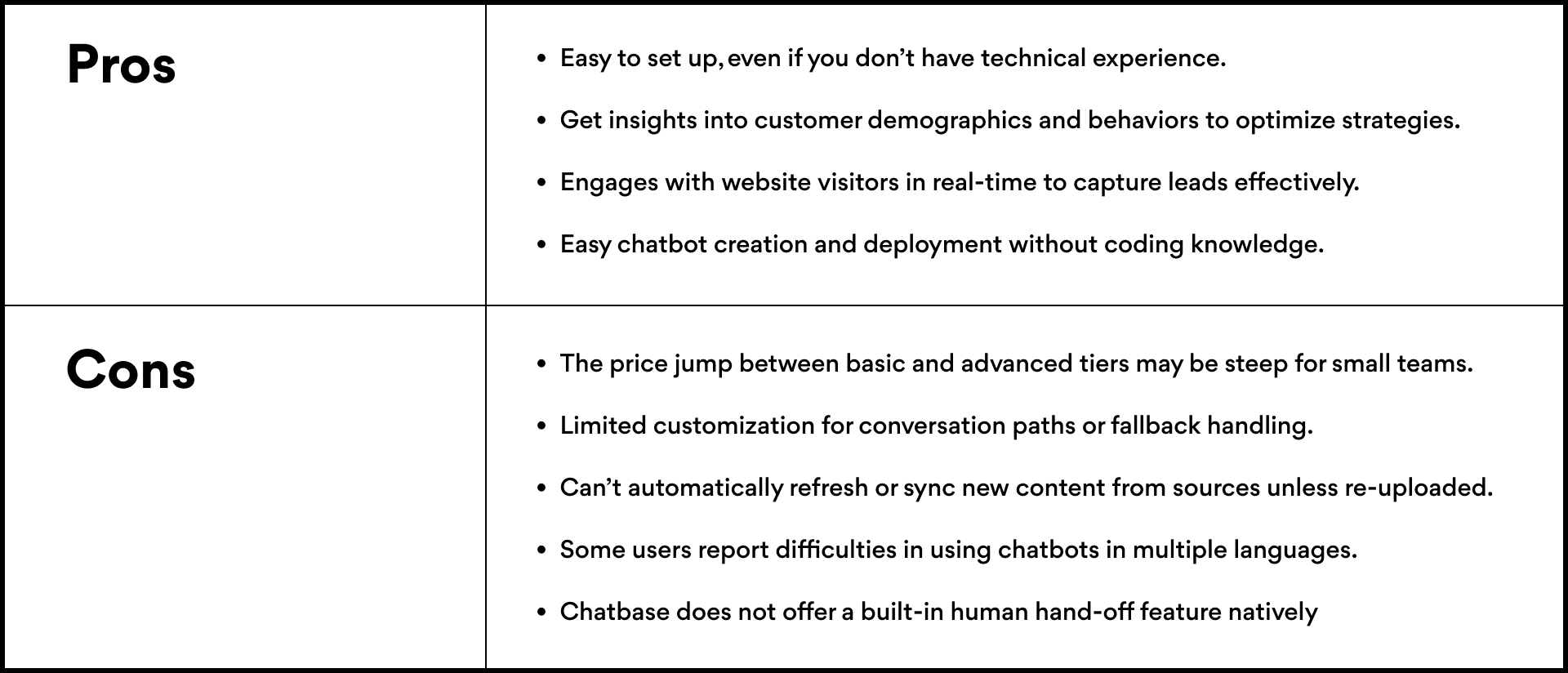
6. Microsoft bot framework
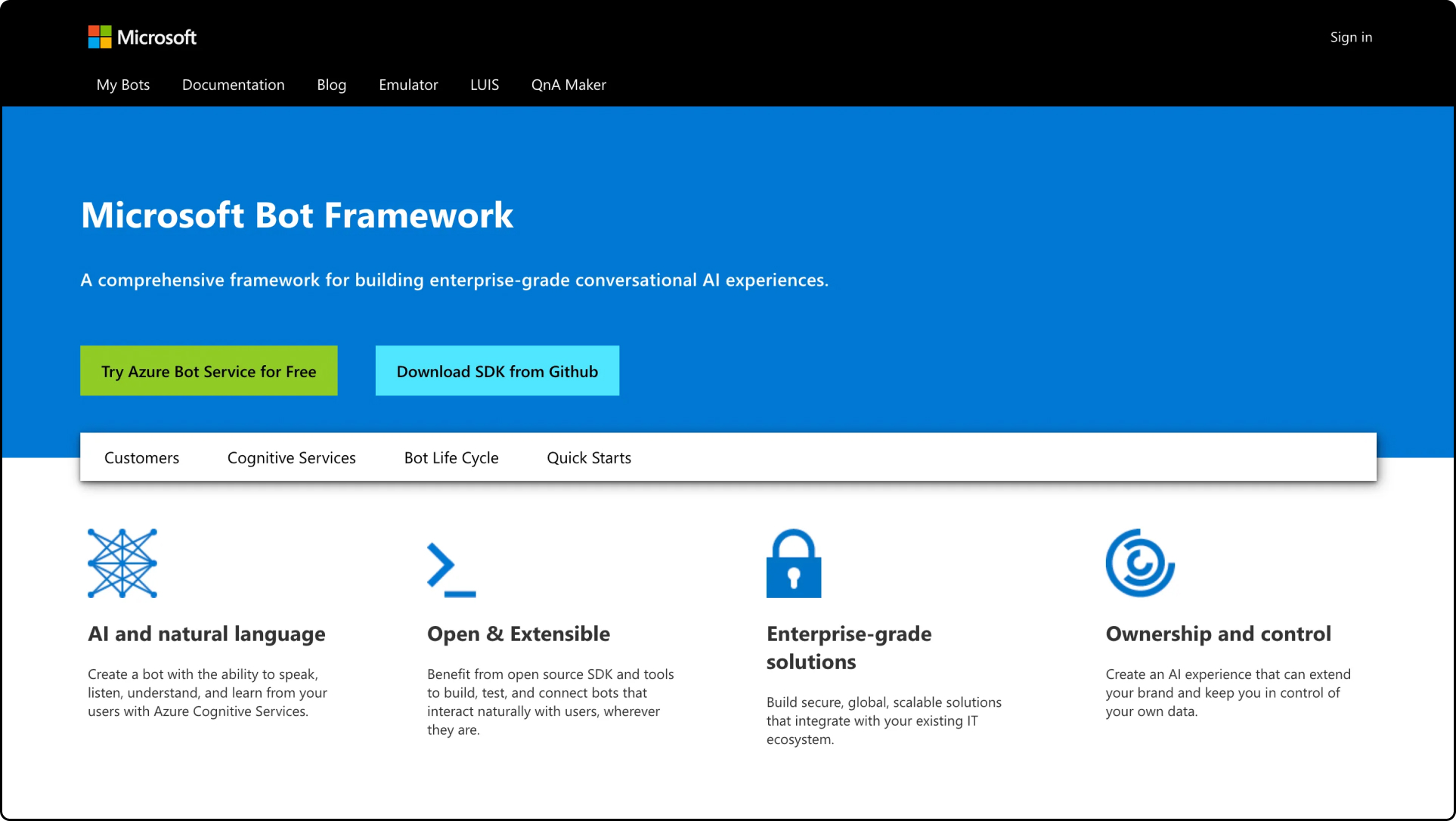
Microsoft Bot Framework is a developer-first platform for building powerful, customizable chatbots. It integrates deeply with Azure and gives full control through a code-first SDK. Ideal for teams building complex, multi-channel bots with advanced logic and enterprise-grade infrastructure.
Key features
- Track performance, user behavior, and channel usage directly in Azure for continuous improvement.
- Reuse conversational modules and language models across multiple bots for faster, modular development.
- Design, test, and deploy conversations visually with Composer’s open-source graphical interface.
- Create complex, multi-turn conversations with built-in logic for state, branching, and personalization.
- Deploy bots across Microsoft Teams, Web Chat, Facebook Messenger, Slack, and more with a single codebase.
- Host, manage, and scale bots in the Azure cloud with built-in connectors, analytics, and reliability.
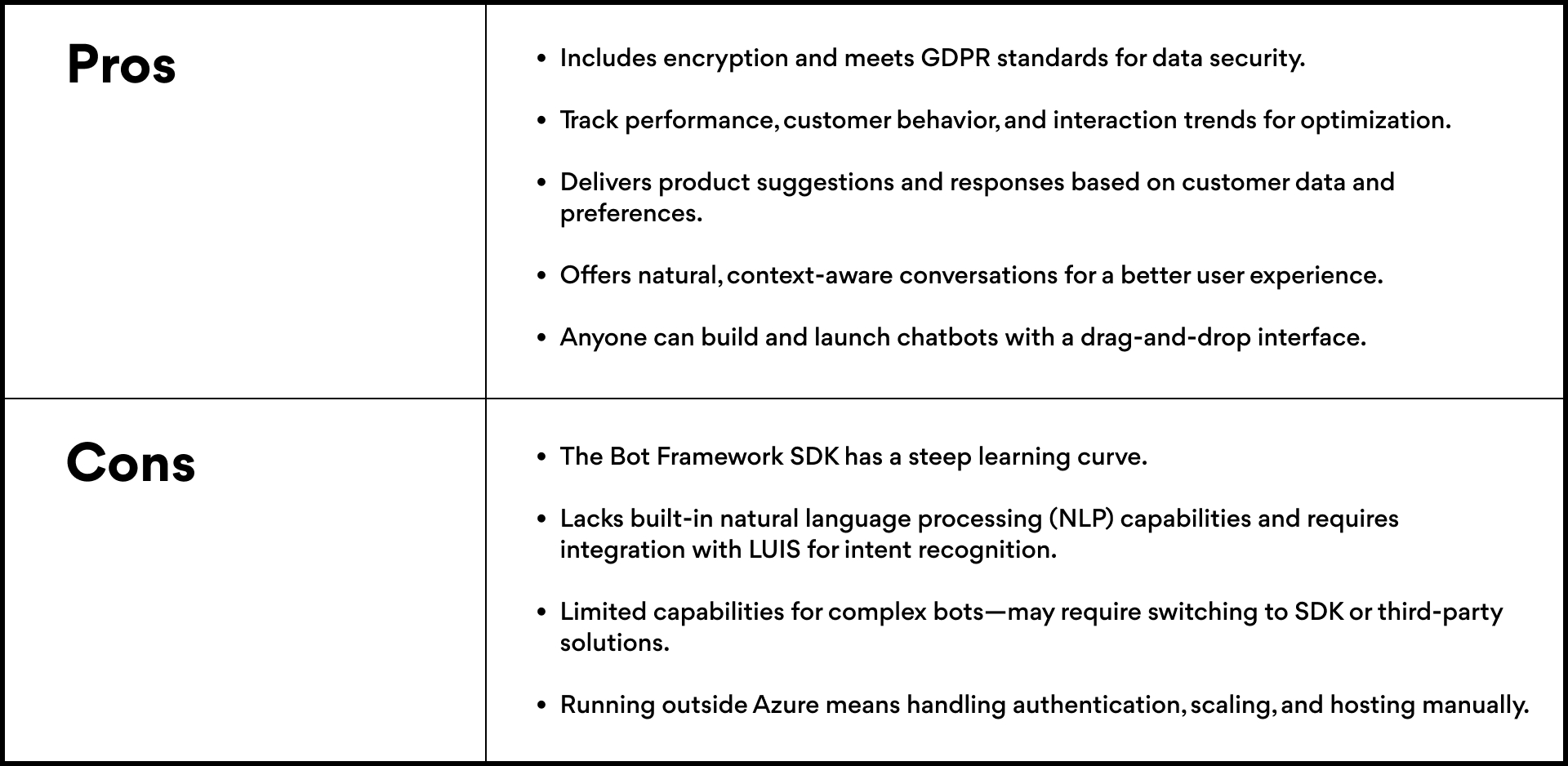
7. Voiceflow
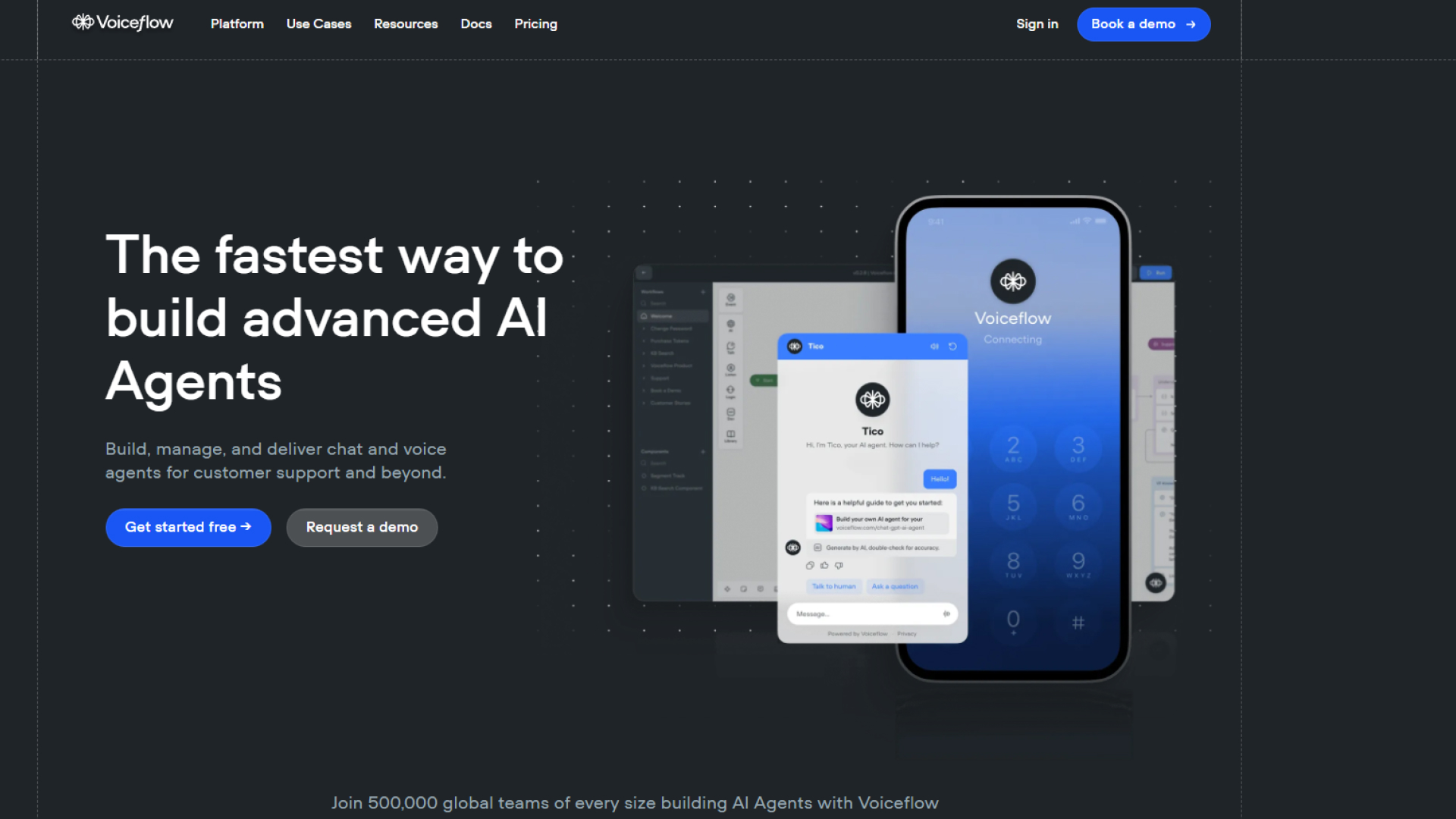
Voiceflow is built for teams designing advanced voice and chat agents. Its visual flow builder makes it easy to map and test complex conversations without code while still offering flexibility for developers. It’s a strong choice for teams working across design and development, especially in voice AI.
Key features
- Design complex conversations using a drag-and-drop canvas with support for prompts, logic, APIs, and user replies.
- Build agents powered by GPT-3.5, GPT-4, Claude, or custom LLMs, combining structured flows with advanced AI.
- Train bots using content from PDFs, websites, and Zendesk with support for vector databases and multiple data sources.
- Work together in real time with shared projects, comments, and role-based access—built for design and dev teams.
- Track performance, review user interactions, and use error insights to refine bot responses over time.
- Simulate and deploy conversations across web, mobile, apps, and voice platforms from a single workspace.

8. Zendesk Support Suite
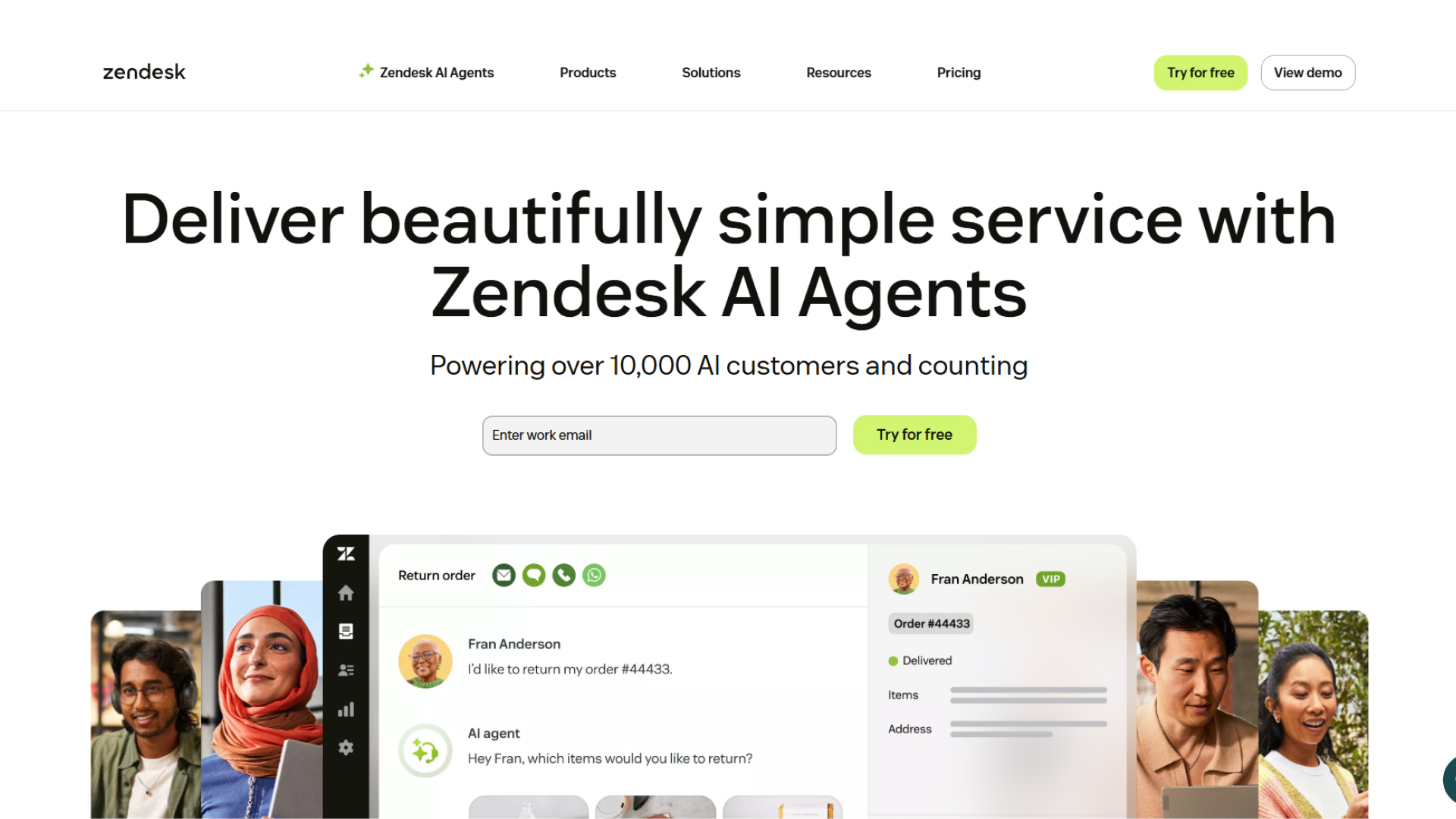
Zendesk is a cloud-based platform for managing customer support, sales, and engagement across multiple channels. It combines help desk tools with AI automation. Its built-in Answer Bot helps deflect common queries, while the overall suite focuses on ticketing, live chat, and self-service support.
Key features
- Manage support across email, chat, voice, social, and messaging channels from a single agent interface for faster, more consistent responses.
- Boost agent productivity with AI-generated reply suggestions, summarizations, and real-time insights directly within the conversation.
- Track, categorize, and prioritize support requests with advanced ticket management tools, custom SLAs, and macros.
- Automate repetitive tasks like assigning tickets, sending follow-ups, and updating statuses to streamline operations.
- Monitor performance with pre-built reports, dashboards, CSAT/NPS tracking, and deflection insights.
- Built-in voice support with advanced features like call transcription, speaker labeling, and automatic redaction of sensitive data.
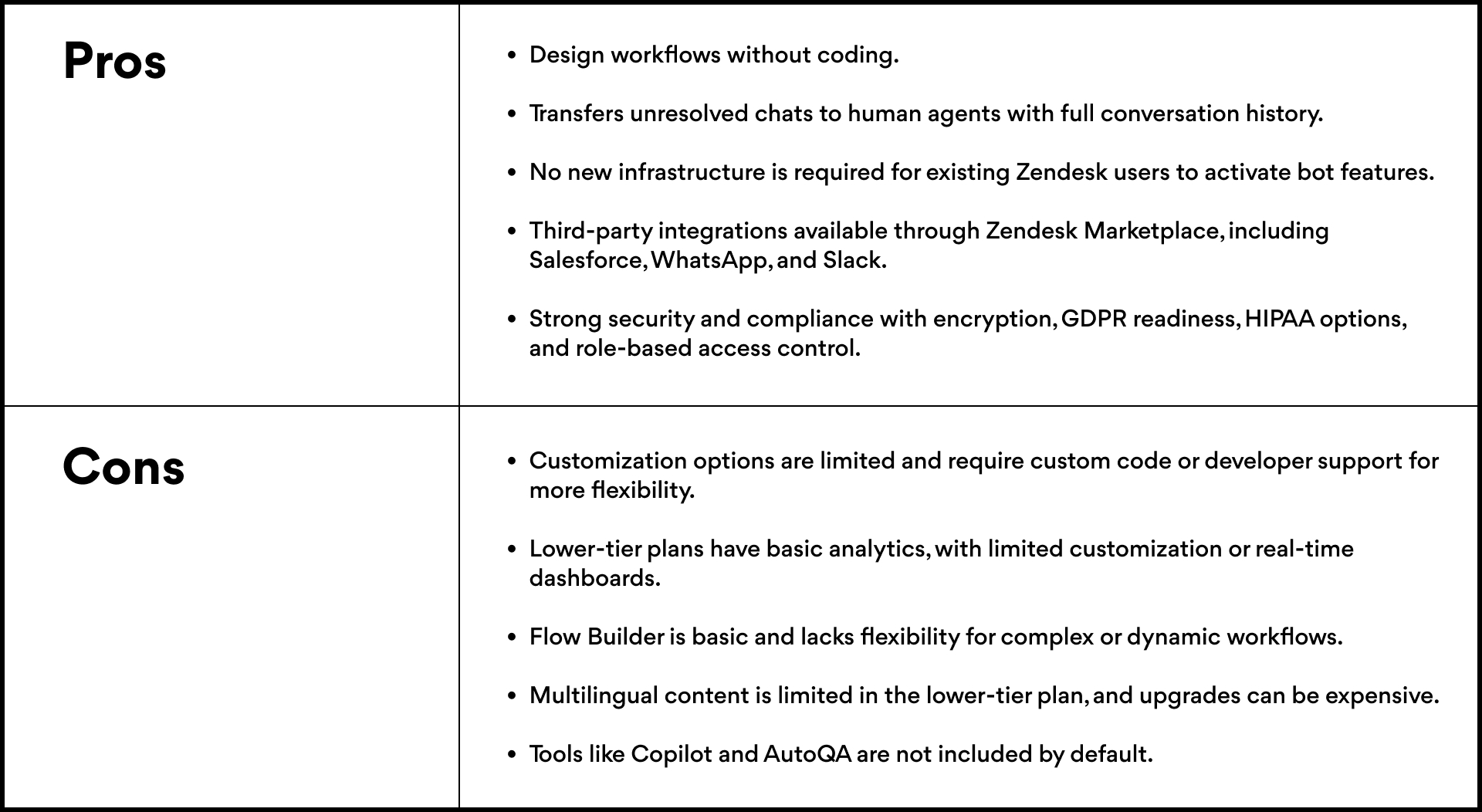
9. Rasa
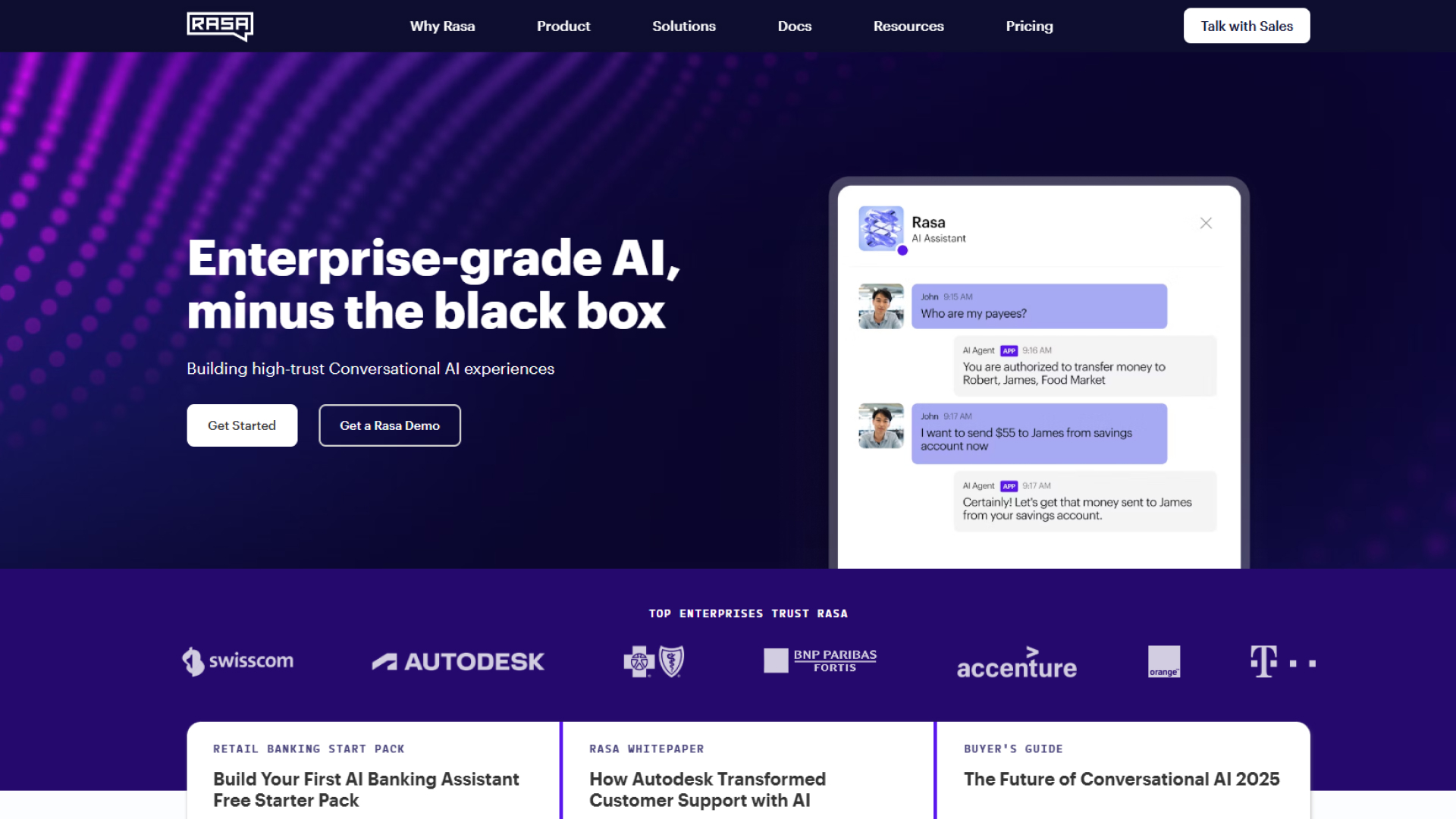
Rasa is an open-source conversational AI platform that helps build smart chatbots and voice assistants that can handle real conversations. It’s powered by CALM, a system that mixes large language models with clear logic, so your bot sounds natural but still stays on track.
Key features
- Rasa gives developers full control with an open-source framework, allowing deep customization across NLP, dialogue logic, and integrations.
- Accurately interpret user messages with advanced intent classification and entity extraction using Rasa’s customizable NLU pipeline.
- Deploy bots across channels like Slack, Microsoft Teams, Telegram, Facebook Messenger, Twilio SMS, and more via built-in connectors.
- Track user conversations, feedback, and performance metrics to optimize bot behavior and user experience.
- Rasa Pro adds advanced features like visual tools, cloud hosting, built-in analytics, and team collaboration for enterprise users.
- Run Rasa on-premise, in the cloud, or in hybrid setups with support for Kubernetes, Docker, and Helm charts.
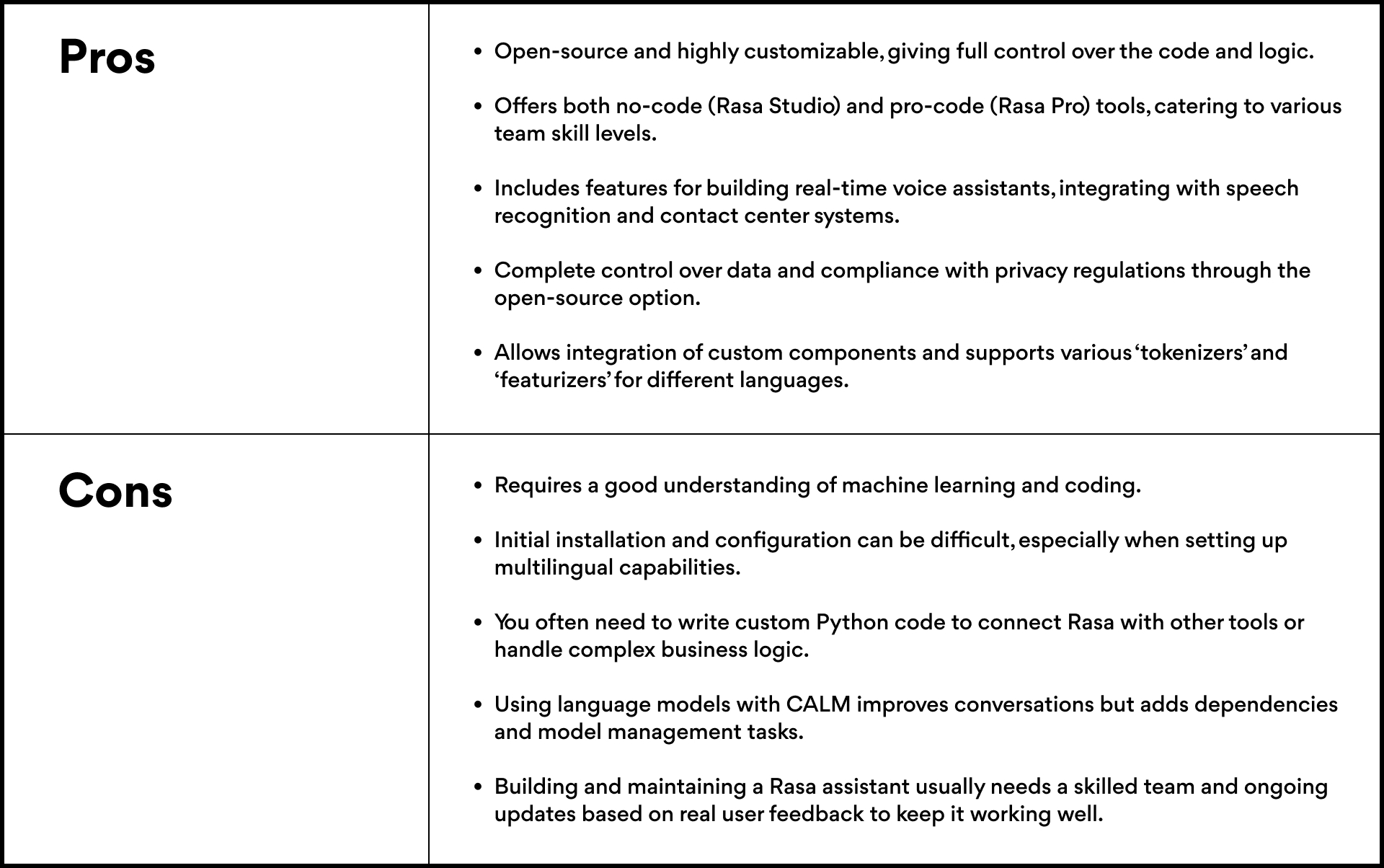
10. Botsonic
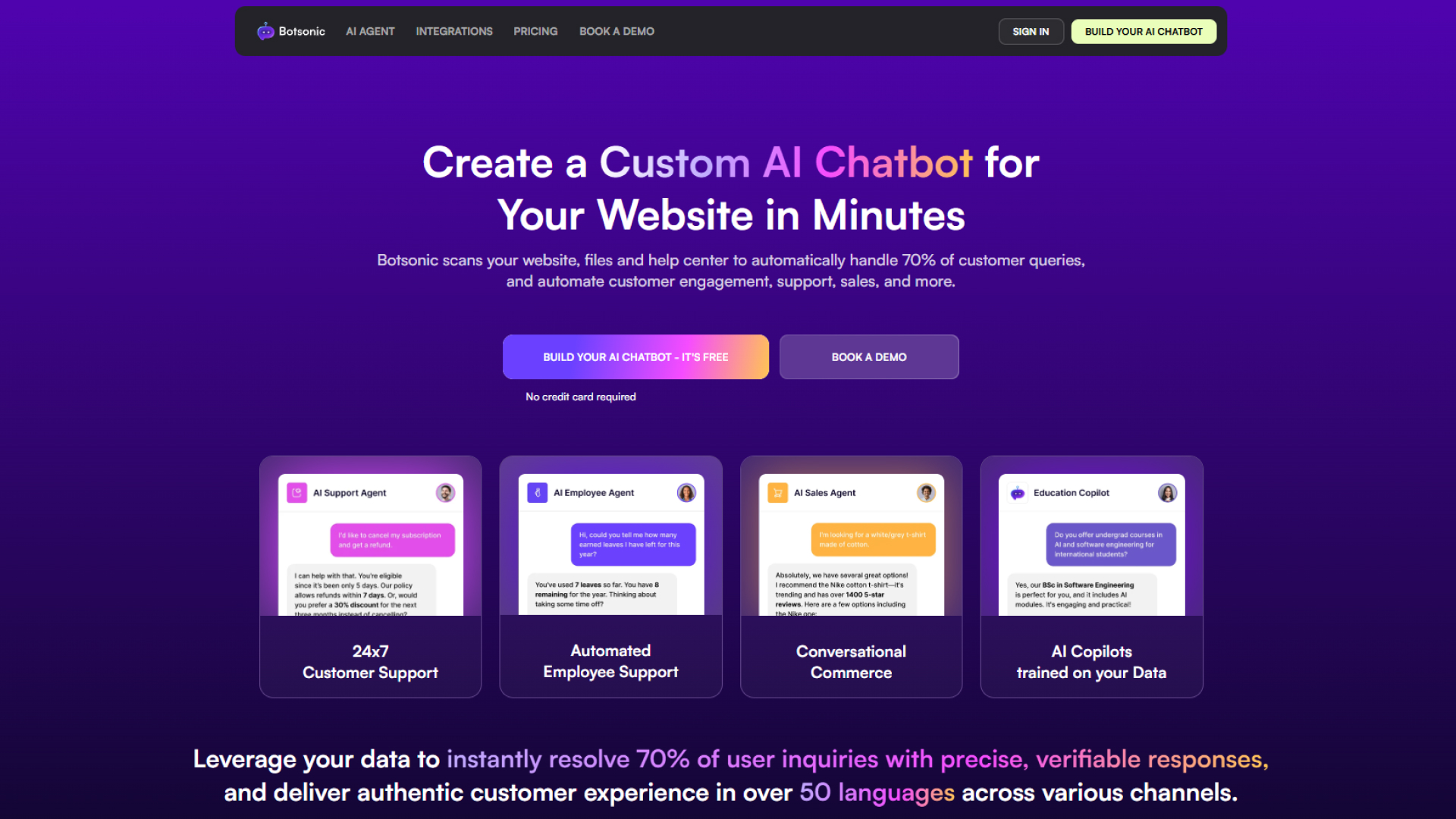
Botsonic is a no-code AI chatbot builder designed to help businesses create custom AI chatbots trained on their own data. Its user-friendly interface allows for easy customization without the need for coding, making it accessible to users with varying technical expertise. Botsonic supports integration with various platforms and offers features such as multilingual support, analytics, and the ability to train chatbots using business-specific documents and websites.
Key features
- Launch bots in minutes and duplicate existing bots (with data) to scale across platforms or use cases efficiently.
- Ensure conversations are encrypted and compliant with data privacy regulations like GDPR.
- Track chatbot performance, conversion rates, and user behavior in real time to optimize engagement.
- Build AI-powered chatbots without writing any code, using a simple drag-and-drop interface designed for ease of use.
- Upload PDFs, websites, DOCs, or knowledge bases to train bots with personalized, brand-specific responses.
- Deliver an authentic customer experience in over 50 languages across various channels.
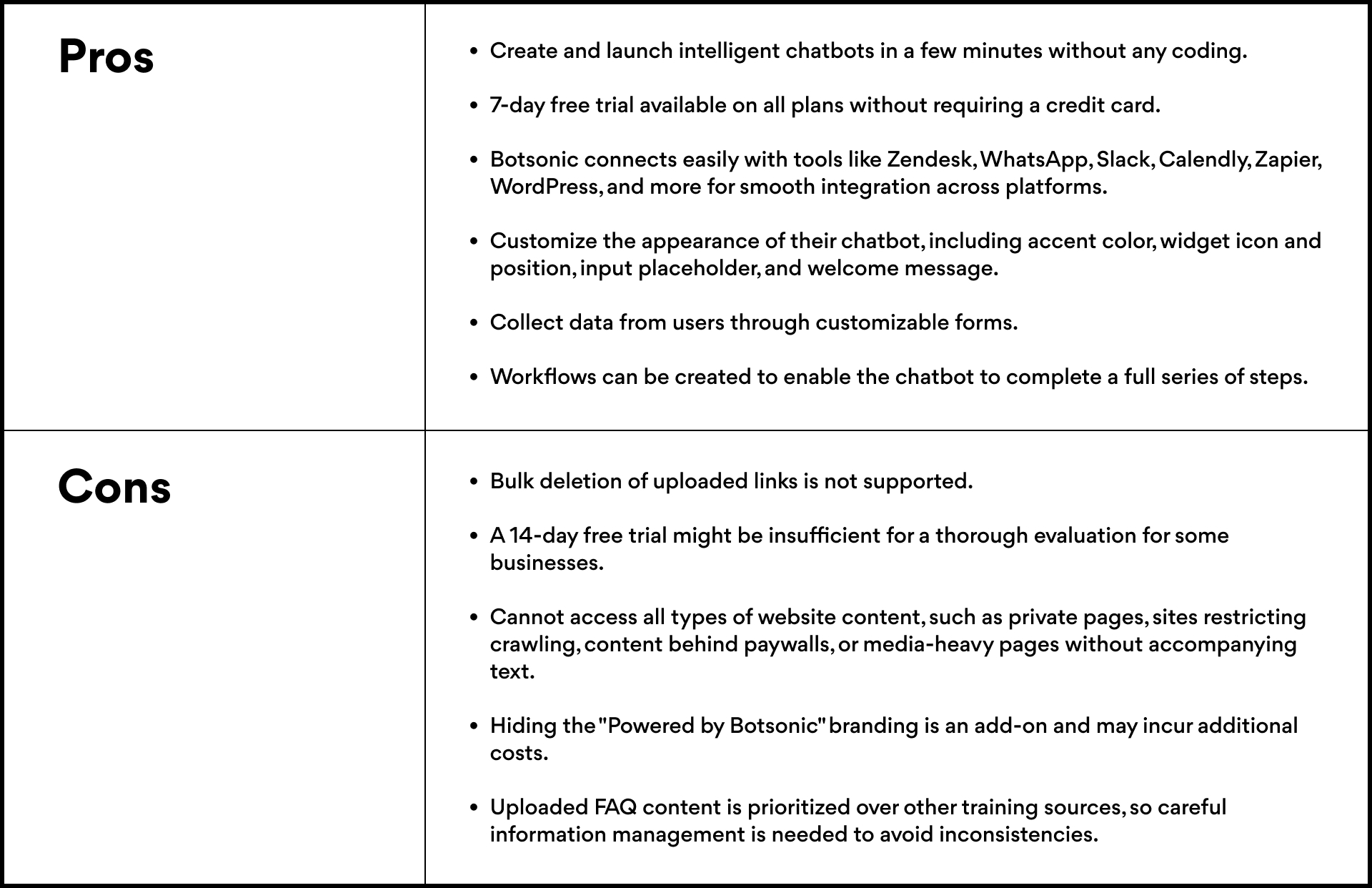
11. Denser AI
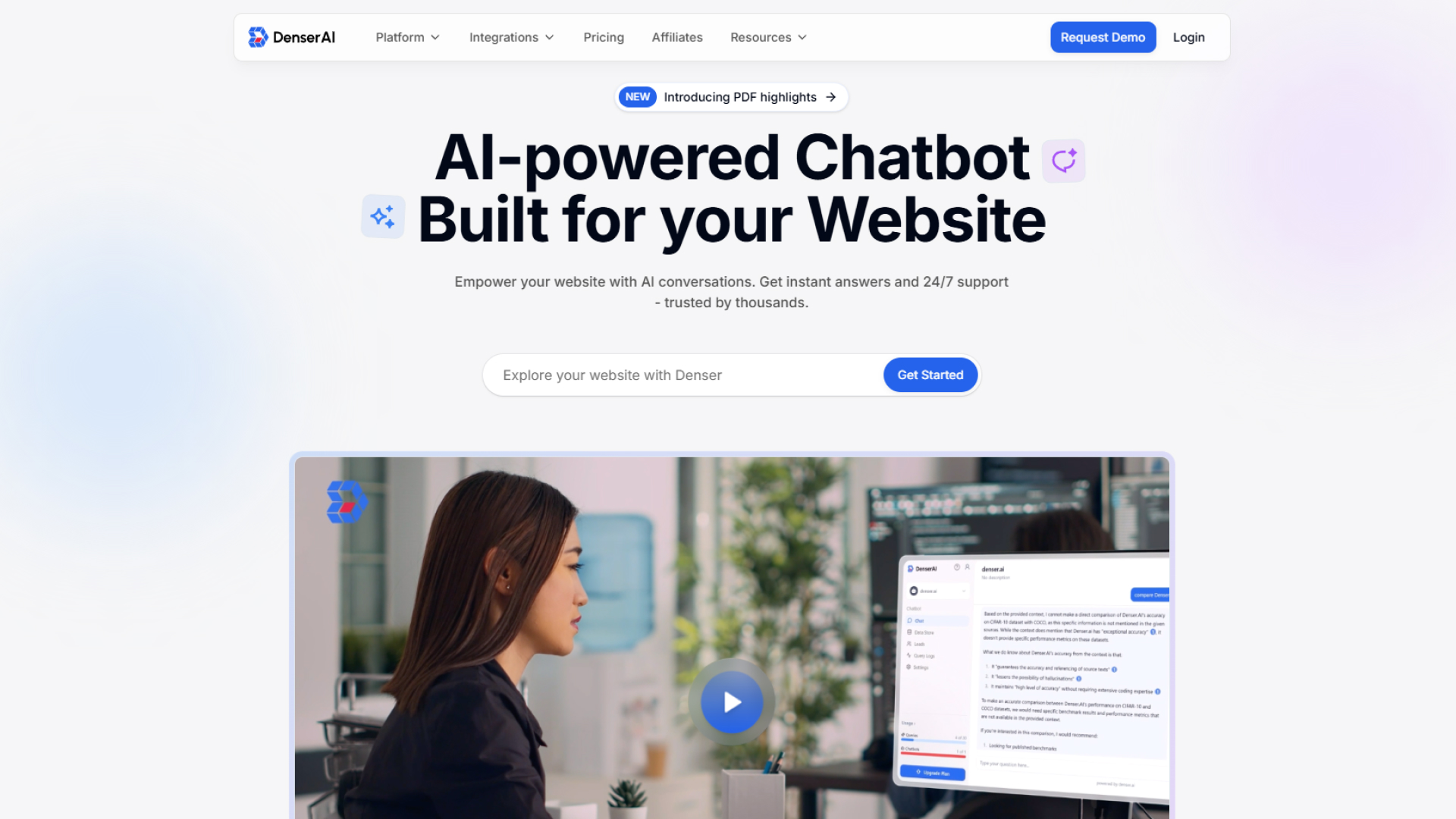
Denser AI is a no-code chatbot platform that delivers context-aware, accurate responses using the latest uploaded or linked content. It’s designed for fast setup, with support for content from websites, documents, and Google Drive. Businesses use it to automate support, capture leads, and streamline operations without needing any technical skills.
Key features
- Respond in multiple languages based on your uploaded content, with context-aware answers drawn from files, websites, and Google Drive sources.
- Match your chatbot’s look to your brand with custom fonts, color schemes, logos, and favicons.
- Track performance, engagement, automation success, and user behavior through actionable insights.
- Launch your chatbot in minutes with a simple script, no coding required.
- Let users search your content using conversational language for more intuitive interactions.
- Enterprise-grade encryption and GDPR-compliant features protect customer data at every step.
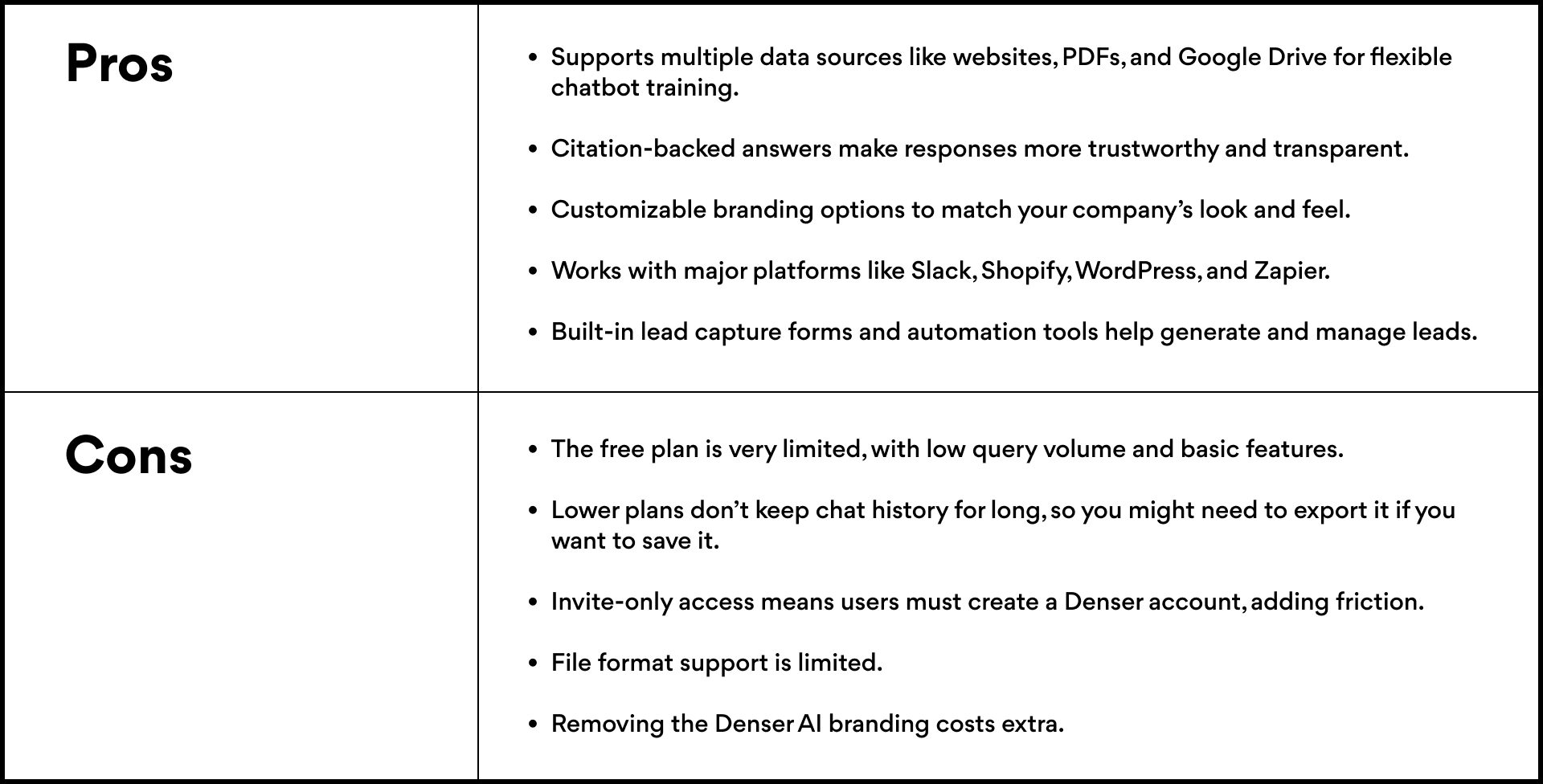
12. HubSpot Service Hub (with Chatbot Builder)
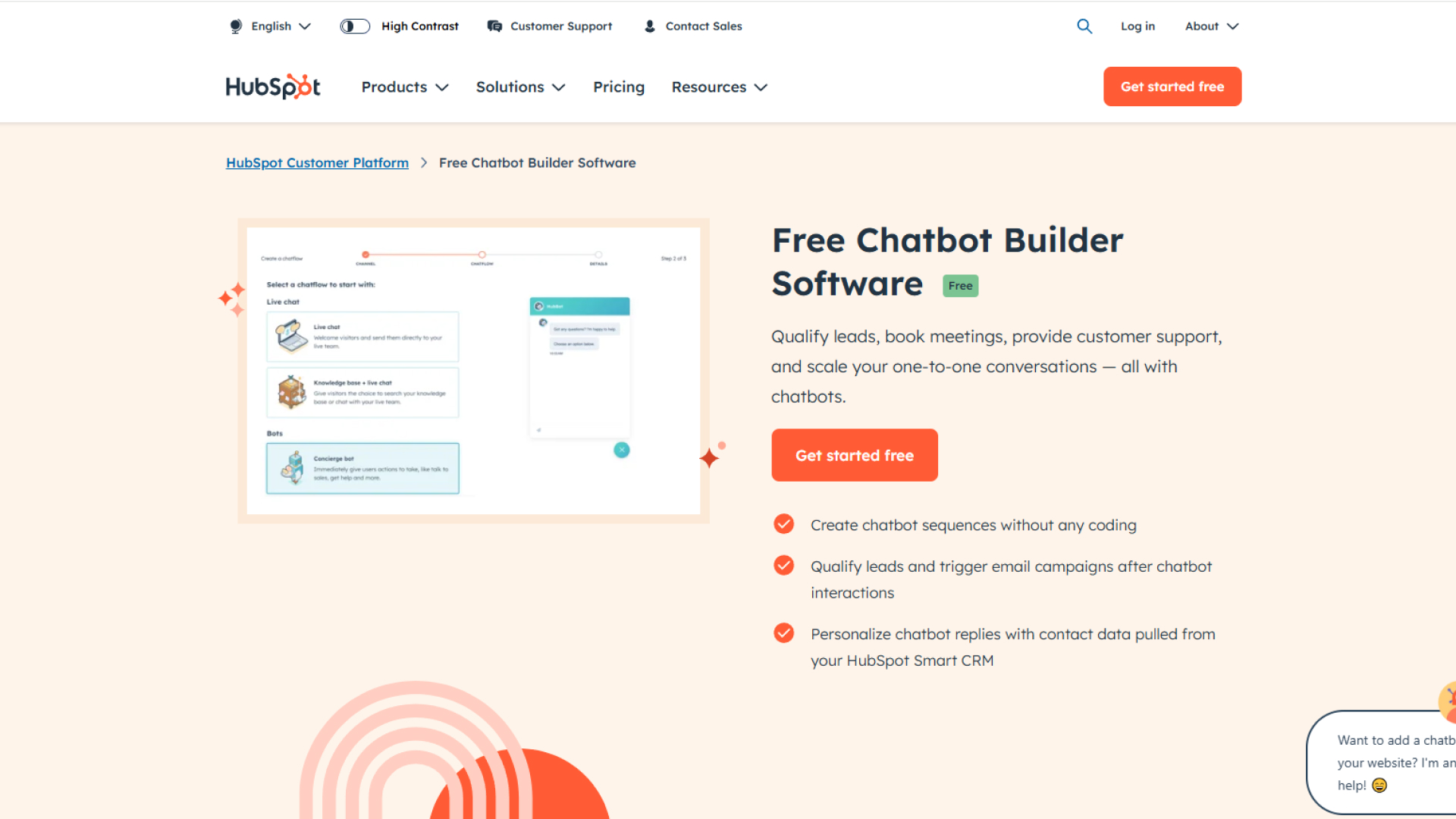
HubSpot Service Hub is a no-code chatbot and live chat solution built into the HubSpot CRM. It helps teams automate support, capture leads, and chat with visitors in real time, all from one place. With features like pre-built templates, ticketing, knowledge base, and branded chat widgets, it’s a good option for SMBs already using HubSpot’s tools.
Key features
- Works seamlessly within HubSpot CRM, giving teams full visibility into customer history across sales, marketing, and support.
- Manage customer conversations from email, live chat, and Facebook Messenger in one shared inbox.
- Chat with visitors in real time and automate responses using a no-code chatbot builder with drag-and-drop flows.
- Collect CSAT, NPS, and CES scores through built-in survey tools to measure satisfaction and improve service.
- Generate help articles and suggest solutions with AI-powered tools based on past customer interactions.
- Let users book meetings directly within the chat interface, integrated with your team’s calendars.
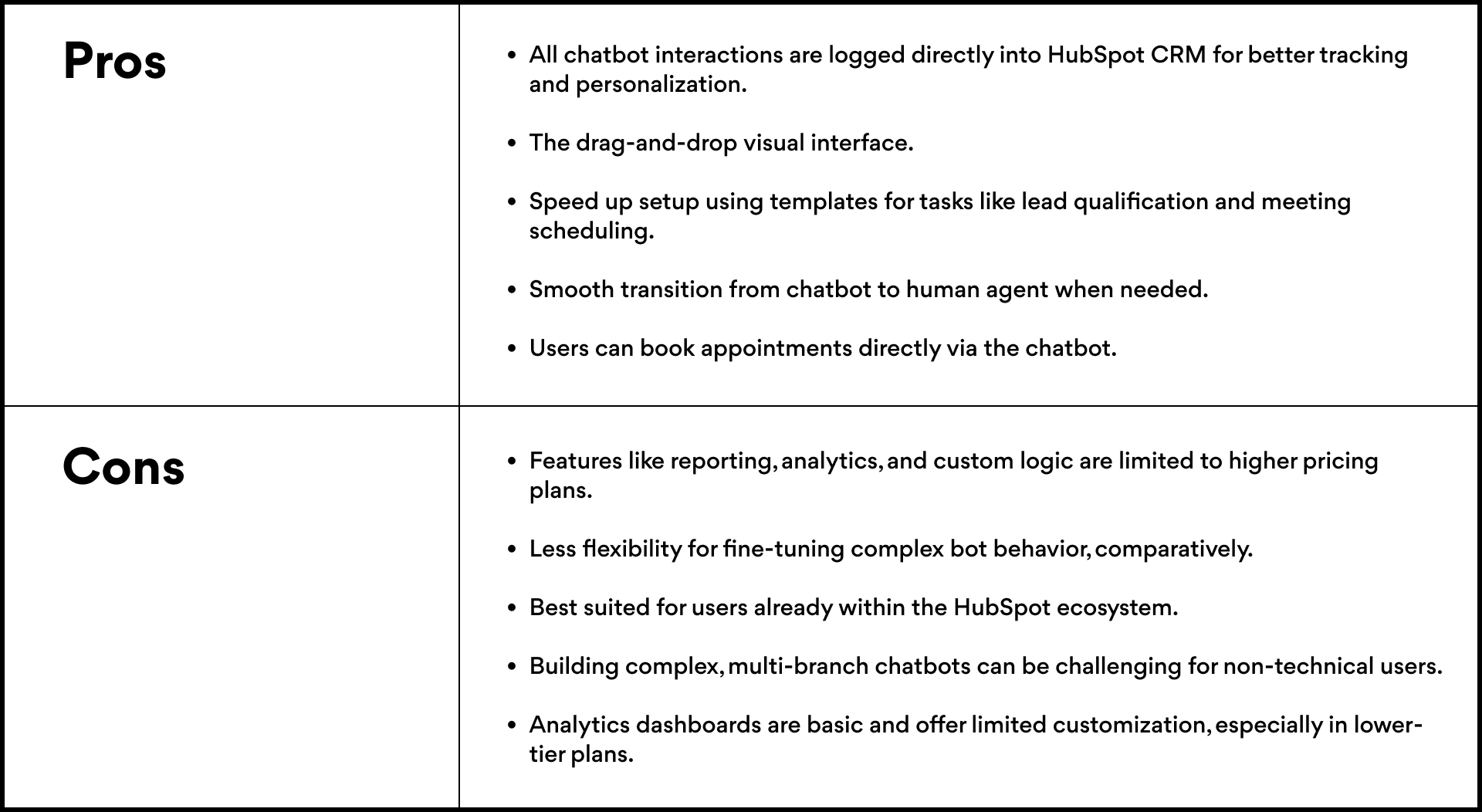
Finding the right fit for your business
Choosing the right Botpress alternative comes down to understanding your business needs, technical capacity, and customer engagement goals. Whether you prioritize no-code simplicity, deep customization, or omnichannel support, the tools in this list offer powerful options across the board.
Thinkstack stands out for businesses looking to move fast without compromising on customization or performance.
Frequently Asked Questions (FAQs)
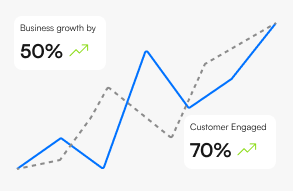
Grow Your Business with AI Agents
- Automate tasks
- Engage customers 24/7
- Boost conversions